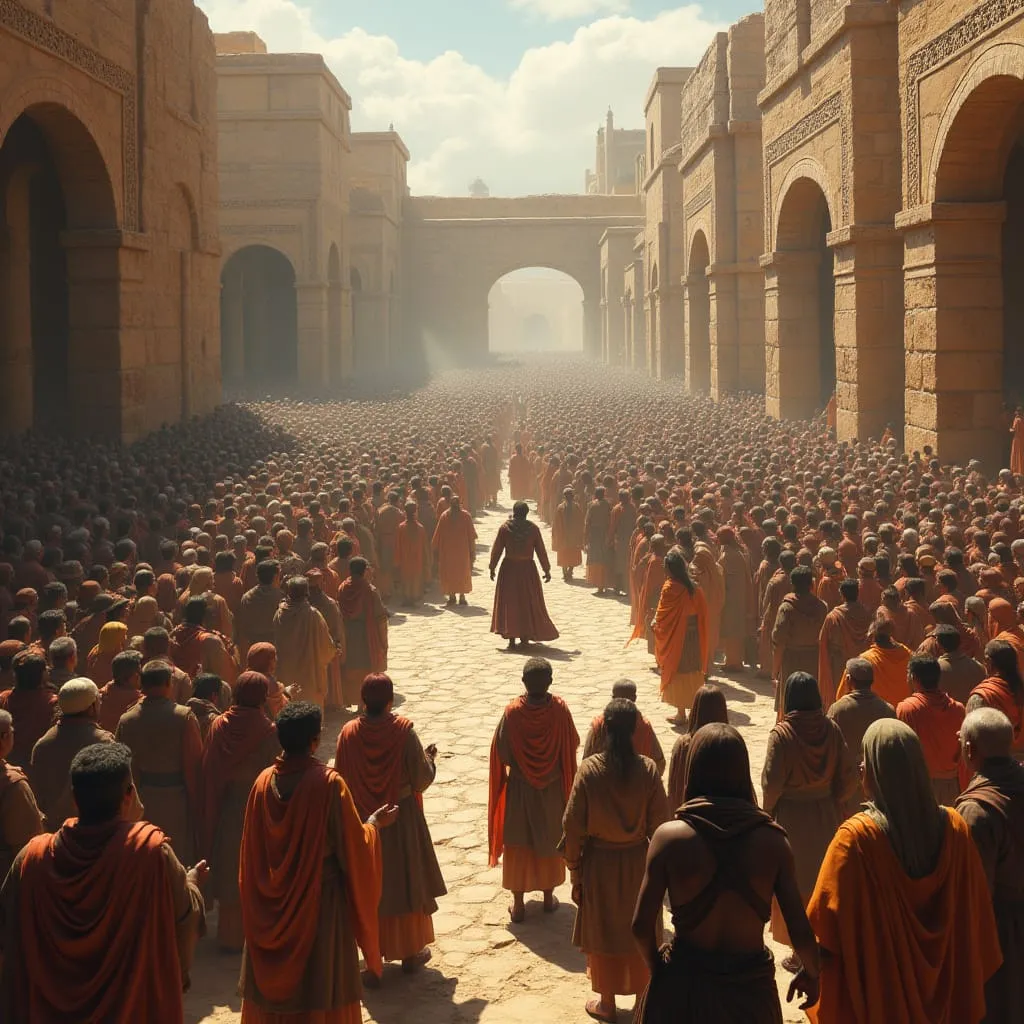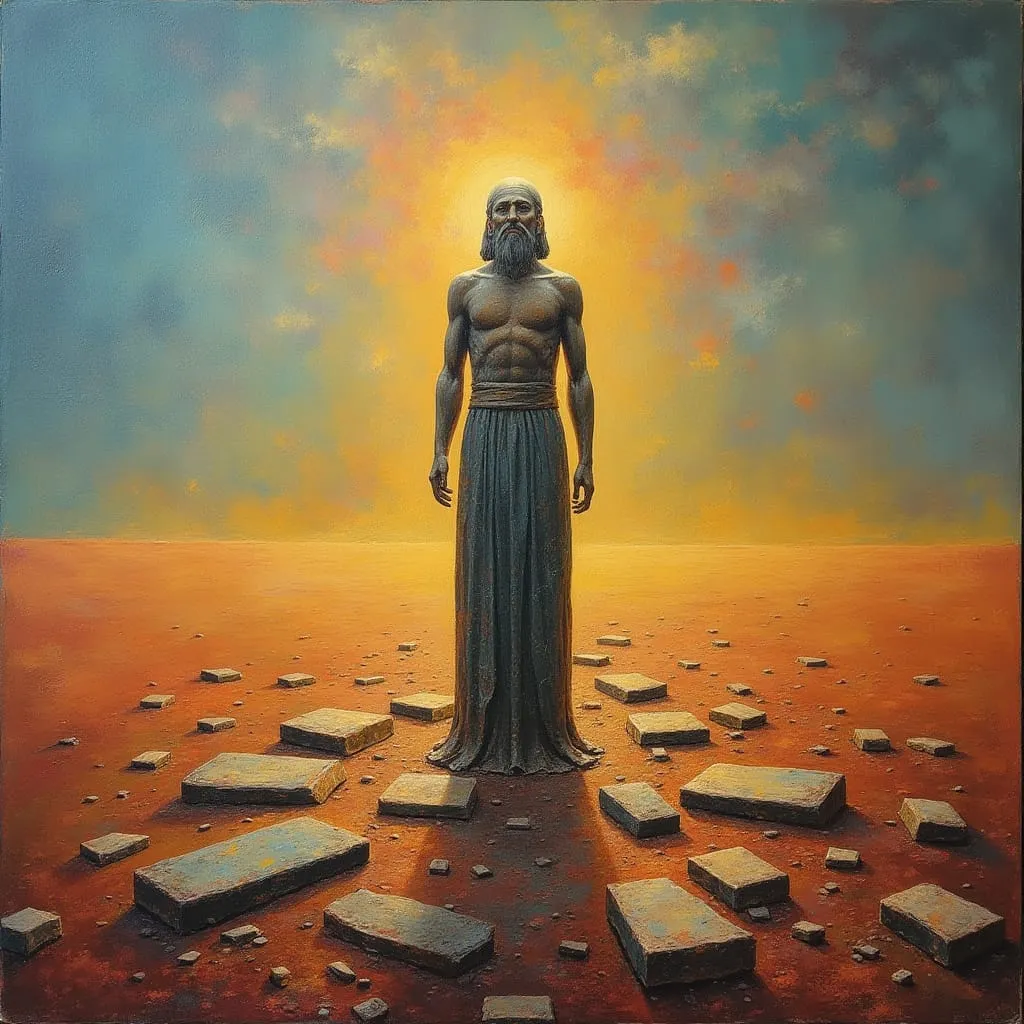Ethics in Ancient Civilizations Beyond the West
Lesson 1. Ethical Systems in Mesopotamia
Hammurabi's Code and Its Ethical Implications
The ethical systems of ancient Mesopotamia were not built on compassion or mercy, but on brutal pragmatism and the absolute power of rulers. Unlike modern ethical frameworks that emphasize individual rights or universal dignity, Mesopotamian ethics were founded on harsh hierarchies, divine authority, and retribution. This lesson explores the unforgiving nature of Mesopotamian ethical systems and their lasting influence on subsequent civilizations.

Ancient Mesopotamian society depicted with its complex social stratification where priests, nobles, merchants, commoners, and slaves existed in rigid hierarchies that fundamentally shaped their ethical systems and concepts of justice.
Blood for Blood: The Foundation of Mesopotamian Justice
Mesopotamian ethics were built on the principle of lex talionis—'an eye for an eye, a tooth for a tooth.' This was not a metaphor but literal policy. Justice was synonymous with retribution, often disproportionately harsh by modern standards. The concept of vengeance as justice was deeply embedded in the social fabric, with the severity of punishment often exceeding the original offense. Crimes against the upper classes carried far greater penalties than identical offenses against slaves or commoners, reflecting a society where moral worth was explicitly tied to social status.
Hammurabi's Code: Institutionalized Brutality
Hammurabi's Code, often romanticized as an early legal achievement, was a testament to state-sanctioned cruelty. Consisting of 282 laws carved in stone, it institutionalized brutal punishments including drowning, burning alive, and systematic mutilation. If a builder constructed a house that collapsed and killed the owner's son, the builder's own son would be put to death—not the builder himself. This demonstrates how Mesopotamian ethics viewed family units as extensions of individual responsibility, with innocent children bearing the punishment for their parents' failures. The code was designed not to rehabilitate or reform, but to terrify the populace into compliance.
Divine Mandate: Gods as Moral Authorities
Mesopotamian ethics derived their authority from gods portrayed as vengeful, capricious, and demanding. Kings ruled as divine representatives, their decrees considered extensions of divine will. Moral failings were viewed not primarily as harm to other humans but as offenses against divine order. This theological foundation for ethics meant questioning authority was not merely political dissent but religious blasphemy. The gods were believed to demand sacrifice and submission, with natural disasters interpreted as divine punishment for moral or ritual failures.
Women and Slaves: Ethical Non-Persons
Perhaps the most disturbing aspect of Mesopotamian ethics was its explicit denial of moral consideration to large segments of society. Women were treated as property, with adultery by a wife punishable by death while male infidelity carried minimal consequences. Slaves had virtually no ethical standing, with their abuse requiring compensation not to them but to their owners for 'damaged property.' Children could be sold into slavery by parents facing debt, with no concept that this violated any ethical principle. The very idea that all humans possess inherent dignity or rights would have been incomprehensible in this ethical framework.
Legacy of Harshness
The Mesopotamian ethical legacy can be seen in the emphasis on harsh retribution that persisted into later legal codes throughout the Middle East and beyond. While modern societies have largely rejected explicit hierarchies of human worth, the concept of punishment as deterrence rather than rehabilitation echoes Mesopotamian thinking. Some religious traditions still carry the theological framework of divine command ethics, where actions are right because they are commanded by deity rather than because of their intrinsic moral quality. Understanding this harsh origin of formalized ethics forces us to confront uncomfortable questions about how much of our current moral intuitions are genuinely humanitarian advancements and how much remains influenced by systems designed to maintain power hierarchies through fear.

Public execution by burning in ancient Mesopotamia—a vivid demonstration of how Hammurabi's Code enforced strict social compliance through spectacles of terror and the public display of harsh retributive justice.
If a man destroy the eye of another man, they shall destroy his eye. If he break a man's bone, they shall break his bone. If a man knock out the teeth of his equal, they shall knock out his teeth.
: Hammurabi's Code demonstrates the literal application of retributive justice without concern for rehabilitation or mercy. This approach fundamentally shaped Mesopotamian society by establishing punishment as spectacle rather than correction. While modern legal systems generally seek to reform offenders, this ancient code focused solely on physical retribution, creating a culture of fear where justice was measured by the symmetry of suffering rather than restoration of social harmony.
If a builder build a house for someone, and does not construct it properly, and the house which he built fall in and kill its owner, then that builder shall be put to death. If it kill the son of the owner, the son of that builder shall be put to death.
: This law reveals the shocking concept of transferring punishment to innocent family members, showing how Mesopotamian ethics viewed justice as maintaining cosmic balance rather than punishing only the guilty.
Summary
Mesopotamian ethical systems represented humanity's first attempt to codify morality on a large scale, but they did so through frameworks that institutionalized cruelty, hierarchy, and divine terror. These systems valued order and authority above compassion or equality, seeing justice as the maintenance of divinely ordained social structures rather than the protection of individual rights. By examining these harsh beginnings of formalized ethics, we gain perspective on how far human moral reasoning has evolved—and how vestiges of these ancient approaches might still influence our thinking today.
Key Points
- In the Code of Hammurabi, the punishment of burning alive was reserved for very serious offenses, often those connected to violating social, religious, or moral order.
- Here are a few examples of situations where burning at the stake could be the penalty:
- Incest: Especially if a man, after his father's death, committed incest with his mother, both were to be burned.
- Looting a burning house: If someone who came to extinguish a fire took advantage of the situation and stole property from the house owner, they were to be thrown into the same fire.
- Operating or entering a tavern by holy woman (priestess): Nuns were forbidden from running taverns or entering them to drink; such an offense was punishable by burning.
- Certain cases of treason and conspiracy: While not explicitly burning alive, other sources suggest that some forms of treason and rebellion could result in cruel death penalties, including qualified ones like burning at the stake.
- It's worth noting that the Code of Hammurabi, though harsh, was also complex. It differentiated punishments based on the social status of both the perpetrator and the victim. Not all capital offenses involved burning. Other forms of execution, such as hanging, drowning, or impalement, were often used.

A surrealist interpretation of Babylon - visualizing the lasting influence of Mesopotamian ethical systems on modern conceptions of justice and authority. Remarkably, certain elements of Hammurabi's hierarchical approach can still be observed in contemporary legal systems, where social context often influences judicial outcomes. This ancient legacy demonstrates how historical legal frameworks continue to shape modern concepts of justice.
Reflection
Consider how your own moral intuitions might be influenced by ancient ethical frameworks. Do you ever find yourself valuing order and punishment over compassion and restoration? How would you design an ethical system that completely breaks from the Mesopotamian legacy of hierarchical moral worth?